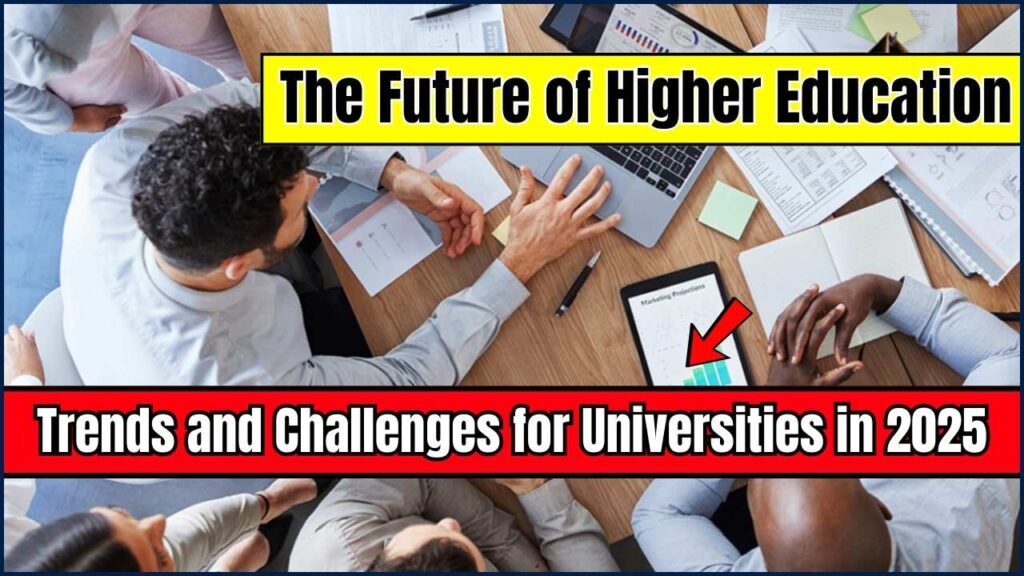
The Future of Higher Education: Higher education in 2025 is not what it used to be. The traditional college setup we once knew is getting a serious makeover. From AI-powered classrooms to mental health becoming a front-row priority, universities are being pushed to adapt to a world that’s changing faster than a TikTok trend. So, what’s the real deal about the future of higher education in 2025? Let’s break it down in plain English and really dive deep into where it’s all headed.
We’re living in a moment where education must either evolve—or risk becoming irrelevant. Students aren’t the same as they were ten years ago. They’re tech-savvy, career-driven, and more aware of the cost-benefit analysis of their degrees. Universities are finally starting to wake up to this new reality.
The Future of Higher Education
| Topic | Key Info |
|---|---|
| AI in Education | 72% of universities now use AI for learning support and admin tasks. |
| Mental Health Services | 4 out of 5 campuses have expanded mental health programs. |
| Career-Focused Learning | Job-aligned degrees and short certifications are booming. |
| Hybrid Learning | Over 60% of courses now include online components. |
| Data Privacy | Universities adopting stricter cybersecurity laws (FERPA, GDPR). |
| Official Resource | U.S. Department of Education |
In 2025, higher education is riding the biggest wave of change since the internet hit dorm rooms. If universities want to survive—and thrive—they need to ditch outdated models and focus on what students actually need: tech-ready tools, real-world skills, and meaningful support. This isn’t just about staying competitive—it’s about staying relevant.
The future’s not just digital—it’s intentional. And the schools that get this right? They’re gonna own the next decade. Expect education to be more modular, more inclusive, and more global than ever before.
Why 2025 Is a Turning Point for Higher Ed
The post-pandemic world forced schools to innovate, but 2025 is where the real transformations are settling in. What we’re seeing is a shift from a degree-for-degree’s-sake mindset to one that values practical outcomes, flexibility, and emotional support.
Today’s students want more than a campus life—they want value. They’re asking, “Is this worth the debt?” And rightly so. With tuition continuing to rise and alternative learning models expanding, universities must now prove they’re worth every penny.
We’re also seeing a huge cultural change. The university experience is no longer defined by ivy-covered walls and packed lecture halls. It’s about accessibility, mental health, and preparing for a world where jobs evolve faster than syllabi.
Major Trends Reshaping Higher Education in 2025
1. AI Is the New Teacher’s Assistant
Forget dusty chalkboards. AI tools like chatbots, smart grading systems, plagiarism detectors, and predictive learning analytics are helping instructors teach smarter, not harder. Schools like Arizona State University are leading the way in using AI to boost retention, personalize course content, and streamline tasks like enrollment and student support.
Students now interact with AI tutors that can answer questions in real time, suggest resources, and even adapt to learning styles. It’s a game-changer, especially for students who need more flexible learning support.
2. Mental Health Is a Core Priority
College ain’t just stressful—it’s overwhelming for a lot of students. Depression, anxiety, and burnout have spiked in recent years. Universities have stepped up big time, offering therapy dogs, virtual counselors, meditation apps, peer-support communities, and 24/7 mental health lines. Some schools are even including mental health in the curriculum, teaching resilience and emotional intelligence as part of the student experience.
3. Degrees That Actually Get You a Job
Traditional degrees still matter, but they’re no longer the only game in town. Micro-credentials, bootcamps, and short-term skill-based certificates are stealing the spotlight. Students are opting for paths that offer quicker returns.
Tech companies like Google and Amazon are now influencing curriculum development by partnering with universities to create job-aligned programs. These credentials are recognized by major employers, bridging the gap between education and employment faster than ever before.
4. Hybrid Learning Is the Norm
Zoom fatigue might be real, but online education is here to stay. Schools are blending the best of both worlds—lecture halls + online modules = flexible, efficient, and accessible learning. Students can now take core subjects online while engaging in-person for labs, field work, and collaborative projects.
Some universities are going all in with global learning platforms, allowing students from different countries to attend the same virtual classroom. That’s next-level diversity and reach.
5. Data Privacy Gets a Makeover
With tech taking over every inch of campus, data privacy is under the microscope. Student info—from academic records to mental health history—is now stored digitally. That’s risky if schools don’t upgrade their systems.
FERPA compliance is the bare minimum. Universities are adopting biometric authentication, two-factor logins, encrypted databases, and GDPR-level transparency to keep student info locked tight.
Challenges That Universities Can’t Ignore
1. Money Trouble & Enrollment Drops
Higher ed ain’t cheap. And students are voting with their wallets. Rising tuition, inflation, and a lack of perceived ROI are causing massive enrollment dips—especially in liberal arts and general studies programs.
Small private colleges are either shutting down or merging to survive. Even big-name schools are trimming departments and freezing hiring. The message is clear: adapt or fade.
2. Declining Public Trust
Let’s be real: folks are side-eyeing colleges more than ever. Between rising debt, elitism, and courses that don’t match market demands, the value of a degree is being questioned. Blue-collar careers, apprenticeships, and tech certifications are becoming more appealing alternatives.
Some states are even launching programs that offer free community college or pay-for-performance funding models. That’s a direct challenge to the traditional 4-year model.
3. Tech Isn’t Cheap or Easy
Turning a campus into a tech-forward institution takes way more than buying laptops. You need IT infrastructure, cybersecurity experts, faculty training, and constant maintenance.
Plus, not every professor is thrilled about the shift. Many are struggling to adapt, especially those used to traditional chalk-and-talk styles. This generational tech gap is slowing down progress at some schools.
4. Academic Freedom Under Fire
Universities used to be places of open discussion. Now? They’re caught in the crossfire of political battles. Discussions around gender identity, race, and even climate change are becoming flashpoints for controversy.
Some administrations are facing pressure to censor or defund programs related to DEI (Diversity, Equity, and Inclusion), while others are doubling down on free speech policies. The struggle for academic freedom is real.
Practical Advice for Students, Parents & Schools
For Students
- Research job placement rates and career support before enrolling.
- Choose programs with built-in internships, co-ops, or portfolio work.
- Don’t ignore community colleges or certification programs—they’re efficient and affordable.
- Stay ahead with skills like digital literacy, data analysis, and communication.
For Parents
- Push for detailed tuition breakdowns and hidden costs.
- Attend campus visits to assess support services and faculty access.
- Encourage kids to explore diverse education paths, not just the Ivy League.
For Colleges
- Ditch legacy systems and invest in user-friendly digital platforms.
- Prioritize mental wellness resources and make them visible.
- Align course content with labor market data and industry feedback.
- Partner with local businesses to offer real-world experiences.
What Experts Are Predicting
- EdTech growth will double by 2030, driven by AI, gamification, and immersive tech like AR/VR.
- Lifelong learning is the new standard. Expect a wave of returning adult learners looking to upskill or pivot careers.
- Global partnerships between U.S., European, and Asian institutions will grow, with shared credentials and international learning portals.
- Student mobility will rise as virtual exchange programs and hybrid semesters become the norm.
According to Deloitte’s 2025 report, colleges that invest in student-centric models will outperform traditional campuses by 22% in enrollment growth.
Frequently Asked Questions About The Future of Higher Education
Q1. Will college still be worth it in 2025?
Yes—if you choose programs that match market needs and offer job-ready training. Don’t just follow prestige—follow value.
Q2. What’s a micro-credential?
It’s a short, focused certification in a skill—like coding, digital marketing, AI basics, or even project management. Often completed in weeks, not years.
Q3. Is AI replacing professors?
Nope. AI is here to help—not replace. Professors still lead the classroom while AI handles repetitive tasks and enhances personalization.
Q4. How can students protect their data?
Use secure passwords, avoid public Wi-Fi for academic portals, enable 2FA, and stay informed on your school’s privacy policies.
Q5. What’s the biggest threat to universities in 2025?
Loss of public trust, outdated models, and slow innovation. If they don’t pivot fast, they risk losing students to ed-tech and alternative credentials.











